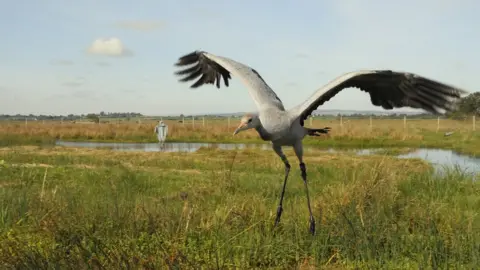Cranes make comeback in Britain's wetlands
 Nick Upton (rspb-images.com)
Nick Upton (rspb-images.com)The graceful crane - the tallest bird in the UK - is making a comeback into Britain’s wetlands thanks to re-introduction and habitat restoration.
It was absent as a breeding bird for 400 years because of wetland drainage and widespread hunting.
Now, an estimated 200 of them are dispersed in Wales, Scotland, the Fens, Suffolk and Gloucestershire.
Their recovery has been glacially slow – in 2019 there’s thought to be just one more breeding pair than 2018.
But the RSPB says population modelling suggests that number will swell much faster soon, as fecundity of the surviving birds improves with age and second generation chicks reach breeding age.
Adult cranes stand at around 1.2m (4ft) and are fabled for their complex “display“ behaviour, where they perform bows, pirouettes and bobs.
 Nick Upton (rspb-images.com)
Nick Upton (rspb-images.com)The crane is thought to have been a common breeding bird in Britain during the Middle Ages. English place names with the prefix ”cran”, such as Cranfield in Bedfordshire, refer to areas frequented by the birds.
Its 400-year absence from Britain ended when a small number returned to the Norfolk Broads in 1979.
Chrissie Kelley, from the Pensthorpe Conservation Trust in Norfolk, said: “We are thrilled to see wild cranes doing so well.
“Seeing these birds in flight is breath-taking and we have regular sightings of them over our reserve.”
They have spread to other areas, benefiting from improved habitat such as at the RSPB’s Lakenheath and Nene Washes reserves as well as Natural England’s Humberhead Peatlands. They re-colonised Scotland in 2012 and Wales in 2016.
Damon Bridge, from UK Crane Working Group, said: “The increase of cranes over the last few years shows just how resilient nature can be when given the chance.
“They are not yet out of the woods, but their continued population climb year-after-year is a very positive sign.”
Follow Roger on Twitter.
